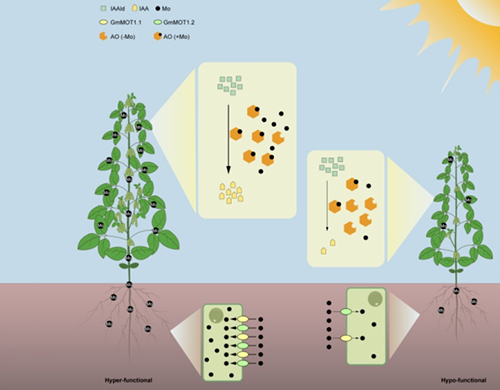According to the Chinese Academy of Sciences, on November 22, the Chao Daiyin Research Group of the Center for Excellence in Molecular Plant Science of the Chinese Academy of Sciences and the Tian Zhixi Research Group of the Institute of Genetics and Developmental Biology published an online publication in Current Biology entitled Natural variants of molybdate transporters contribute to yield traits of soybean by Research papers affecting auxin synthesis. In this study, two key genes regulating the natural variation of molybdenum content in soybean grains, GmMOT1.1 and GmMOT1.2, were cloned through genome-wide association analysis. The results showed that these two genes increased the photosynthetic area of soybean leaves by promoting molybdenum-dependent auxin synthesis in soybean leaves, thereby increasing soybean yield. In addition, the study also found that the two genes have five haplotypes, and the geographical distribution of these haplotypes is closely related to soil pH, which can provide molecular markers for customized soybean breeding adapted to different soil types.

Molybdenum (Mo) is an indispensable trace element in plant growth and plays an important role in several biological processes. For leguminous plants, molybdenum fertilizer is particularly important. In agricultural production, it is often necessary to increase the production potential of legume crops by applying foliar molybdenum fertilizer. It is generally believed that the ultra-high demand for molybdenum fertilizer in leguminous plants is related to the high demand for molybdenum in the process of biological nitrogen fixation of leguminous plants. However, this theory conflicts with the need to sprinkle molybdenum fertilizer on the leaves in production. This is due to the fact that nitrogen fixation in nodules occurs in the roots, but there are no reports of transport of mineral nutrients from leaves to roots in plants. Therefore, there may be an unknown mechanism for the cause of foliar molybdenum fertilizer to promote production.
Soybeans are one of the main crops and are the main source of protein and oil for humans. However, it is unclear whether there are natural variations in the ability of different soybean varieties to absorb and utilize molybdenum, how these variations affect soybean production, and how these variations can be exploited.
In this study, we cloned two genes that regulate the natural variation of molybdenum content in soybeans, GmMOT1.1 and GmMOT1.2, using ionomics and genome-wide association analysis. Through further analysis, it was found that the natural soybean strain contained five major haplotypes of GmMOT1.1 and GmMOT1.2. Among them, the expression level and molybdenum transport capacity of the fifth haplotype were the highest in soybean, while the expression level and molybdenum transport capacity of haplotype 4 were the lowest. A series of genetic and molecular experiments showed that GmMOT1.1 and GmMOT1.2 were involved in the absorption of molybdenum by soybean roots and the transport of molybdenum from shoots by roots. When the function of GmMOT1.1 and GmMOT1.2 decreased, the molybdenum content and yield of mutants were significantly reduced, while the enhancement of GmMOT1.1 could significantly increase the molybdenum content and soybean yield. Therefore, these two genes regulated the molybdenum content in the shoots of soybean and further affected the soybean yield.
The study showed that GmMOT1.1 and GmMOT1.2 did not affect the nitrogen fixation ability of root nodules, nor did they affect other nitrogen assimilation processes. The auxin content of leaves was significantly changed in mutants and overexpressing GmMOT1.1 and GmMOT1.2. Among them, the auxin content in the leaves of the mutant was significantly decreased, while the auxin content in the leaves of the overexpressed lines was increased. Furthermore, the results showed that there was a molybdenum-bound aldehyde oxidase in soybean leaves, which could catalyze the synthesis of indole-3-acetaldehyde (IAAld) from auxin indole-3-acetic acid (IAA), but the catalytic activity depended on the content of molybdenum. Therefore, when the functions of GmMOT1.1 and GmMOT1.2 became stronger, the molybdenum content in the leaves increased, which promoted the synthesis of auxin and the growth of leaves, which in turn increased the yield of soybean. This explains why soybean yields can be boosted in agriculture by spraying molybdenum fertilizer directly from the leaves.
In addition, the study also found that there was a close association between the distribution of different haplotypes of the two genes in different growing areas in China and soil pH. The highly functional haplotypes were mainly distributed in acidic low-molybdenum soil areas, while the weakly functional haplotypes were more distributed in alkaline high-molybdenum soil areas, indicating that the two were artificially selected. This suggests that these two genes can be used to design molecular markers for the development of customized soybean high-yielding varieties adapted to soils with different pH levels.
This study revealed the genetic mechanism of natural variation of molybdenum content in soybean grains, clarified the principle of molybdenum fertilizer in legume crops, and explored the molecular markers of soybean breeding customized according to soil pH, which provided a scientific basis for further optimizing soybean planting and breeding strategies and cultivating nutrition-efficient soybean varieties.
